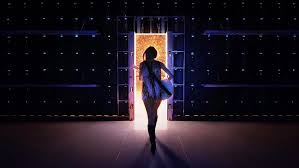The Grimm Variations Review 2024 Tv Show Series Cast Crew Online
There are many fairy tales about beautiful princesses and talking animals in faraway lands — but the stories they come from are often harsher in tone and cruel in intentions. 18th century brothers Jacob and Wilhelm Grimm collected European folklore in its raw form in their book Grimms’ Fairy Tales. Taking a page from the Grimms’ playbook, Netflix’s The Grimm Variations combines the power of anime and the allure of the mysterious.
The Grimm Variations is an anthology; each episode centers around a famous fairy tale with an added twist. While the telltale signs of the medieval age make the Grimm adaptations inherently darker, Netflix’s ONA [Original Net Animation] treats curiosity and wickedness as a timeless aspect of human nature. The stories change genre, settings, and even their country of origin… but the themes remain true to their source material. No two stories are the same, either in pacing or in direction — meaning that there’s something unique for everyone.
The Grimm Variations opens with the much-adapted story of Cinderella. It begins in the same fashion as the original story did: with a sudden shift in the status quo as new characters enter the household. But Cinderella isn’t as innocent as she looks. The tale quickly spirals into an anxiety-inducing tale in which the audience can see everything, yet do nothing except watch the horrors unfold. The claustrophobic corridors and dimly lit stairs create a shadow of fear, ending the first episode on a note worthy of the Grimm name.
Although the second episode is called “Little Red Riding Hood,” the plot focuses on the Big Bad Wolf on an allegorical level. The story follows a man named Gray, who lives in a virtual reality-obsessed future. He wants to feel reality — but he craves inflicting pain and death on others to get there. From its morbid depiction of its characters to its sudden violence for shock value, this version strays the furthest from the original fairy tale. But fortunately, the stories mellow out from there.
Episode 3’s adaptation of “Hansel and Gretel” sees them living with several other children, under the careful observation of their parents. The plot takes a turn when the duo is sent into the woods as punishment. When they arrive at the witch’s hut, it is not a cannibalistic crone but knowledge that awaits them. The episode’s slow pace lets the episode ferment while also creating a stagnant atmosphere. Hansel finds it easier to give in to his inquisitiveness as the episode goes on. However, he has no idea of the consequences of his actions, ultimately turning a lighthearted adventure into a bittersweet affair.
Most forms of “The Elves and the Shoemaker” are heartwarming and seen as a moral for kindness and hard work — but Episode 4 is unapologetically critical in its exploration of creativity and plagiarism. A novelist’s career soars when mysterious manuscripts in his handwriting make him popular amongst publishers… but he neither remembers writing nor conceiving them. This tug of war between fame and ownership forms the crux of the episode, and its horror comes from a simple question that is both incriminating and infuriating.
The penultimate episode actually has fun with its plot and utilizes the Wild West setting to its fullest. The Grimm Variations’ version of “Town Musicians of Bremen” uses vigilante humans in lieu of animal protagonists, replacing the tomfoolery with a serious tale around righteousness and justice. This anime episode is packed with action and cowboy references, with the adventure of Inu and her merry band of women making viewers forget about the dark premise of the show.
The finale takes inspiration from “The Pied Piper of Hamelin.” When a hooded figure comes to town bearing gifts, forbidden emotions begin to stir. This how a fairy tale is supposed to be, with characters dreaming above their station and a strange fate sweeping them off their feet. But in a story with morally gray characters, the tension is palpable, and the absurdity takes time to hit. When it does, it almost has a Studio Ghibli-esque feel — except for the questionable acts the characters commit for their own selfish gratification. It’s the most restrained of a handful of episodes which all take audiences by surprise.
The only thing connecting The Grimm Variations’ episodes stylistically is the prologues, in which Jacob and Wilhelm talk about their new story and are joined by their little sister Charlotte. Other than that, each episode embarks on its own journey, manipulating each story’s themes to conform with the time and place. This sets the Netflix anthology apart from most darker versions of well-known fairy tales. “Cinderella” opens in a lavish Japanese home, in an era that would have been considered the future when the Grimms wrote their first book. Genres change from episode to episode, shifting between science fiction and surreal hyperreality.
Thematically, however, human emotions are still at the core of every episode. The Grimm Variations understands that darker themes make up the stories, but the characters give them life. Each episode is plot-driven, but everyone from the protagonist to the supporting cast has a hand in said plot. Their flaws push the story toward new and, at times, shocking avenues — because the characters’ own nature seals their fate, whether it’s Grey and his tendency to kill or Writer N and his pride. The audience is captivated by The Grimm Variations because they worry about the characters and in some cases, even feel sorry for them.
The Grimm Variations is a collaborative effort between CLAMP and Wit Studio, the latter of which is famed for anime like Attack on Titan and Vinland Saga. Yet the distinct visual look comes from CLAMP’s character designs. In the prologues, every character has big eyes and looks softer around the edges — the quintessential aesthetic of shoujo art. Wit paints these scenes with a watercolor effect, thus setting them apart from the remainder of the episode and providing a subversively calm effect. Animating each episode in different styles with the signature look of a distinct era and locale while also taking care of minute cultural details is no small feat. Somehow, Wit Studio not only pulls it off but makes The Grimm Variations an immersive experience.
The Grimm Variations further sets the mood with its music. For the most part, composer Akira Miyagawa seems to take his inspiration from Western music. Sometimes it is jazz; other times he serenades the audience with an elaborate piano rendition of Chopin’s Minute Waltz. In “The Town Musicians of Bremen,” he paces the music with the action, combining harmonica and Beethoven’s Für Elise to create a beautiful standoff. That small moment is indicative of what makes The Grimm Variations Season 1 worth watching. It updates fairy tales with modern ideas, but in such a way that every episode feels unique — and yet shows that the themes still remain the same.




